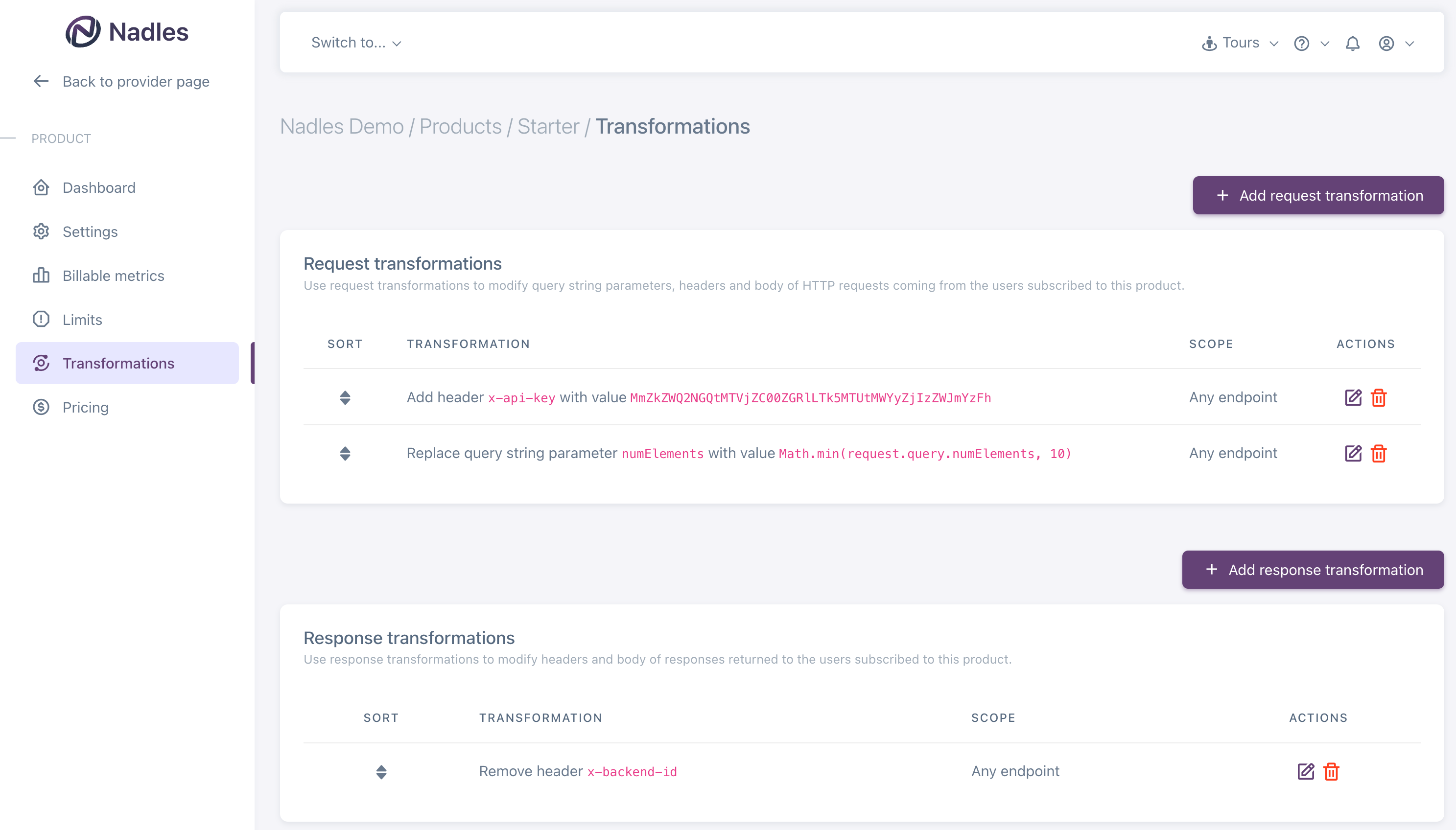Overview
Transformations allow you to dynamically modify requests and responses. That includes headers, query string parameters and body.
How it works
To configure transformations, navigate to Products → select product → Transformations.Headers
The transformation will add/replace/remove headers in a request or response. Header names are case-insensitive.Add
Adds a new header, even if there is already one with the same name.ExampleOriginal request:Transformation:Transformed request:
Replace
Replaces header(s) with a new value. If there are several headers with the given name, they’re removed and replaced with the new value.ExampleOriginal request:Transformation:Transformed request:
Remove
Removes all headers with the given name.ExampleOriginal request:Transformation:Transformed request:
Query string parameters
The transformation will add/replace/remove query string parameters in a request. Query string parameter names are case-sensitive.Add
Adds a new query string parameter, even if there is already one or more with the same name.ExampleOriginal request:Transformation:Transformed request:
Replace
Replaces query string parameter(s) with a new value. If there are several query string parameters with the given name, they’re removed and replaced with the new value.ExampleOriginal request:Transformation:Transformed request:
Remove
Removes all query string parameters with the given name.ExampleOriginal request:Transformation:Transformed request:
Body
The transformation will add/replace/remove request/response body.Add
Adds a new body. If a request or response already has a body, it’s left unchanged.ExampleOriginal request:Transformation:Transformed request:
Replace
Replaces the body with a new value. If there is no body yet, it’s added.ExampleOriginal request:Transformation:Transformed request:
Remove
Removes the body.ExampleOriginal request:Transformation:Transformed request:
Expressions
JavaScript
You can use JavaScript expressions in your transformations to make them even more dynamic. Expressions must evaluate to a new string value for the header/query string parameter/body.Examples
Example — News APISay, you provide an API endpoint that returns contents of a news article. E.g.,For your “Free” product, you’d like to return only the first 120 characters of article body.With the following transformation added to the “Free” product, you configure Nadles API Gateway to do that: Note that the expression evaluation result is used as the new value for the response body.
Note that the expression evaluation result is used as the new value for the response body.
 Note that the expression evaluation result is used as the new value for the response body.
Note that the expression evaluation result is used as the new value for the response body.Expression variables
There are several variables you can use in your expressions.Path parameters
path.params.* — placeholder values specified in the endpoint URL.
ExampleIf an endpoint URL is
/resource/{resourceId}and the HTTP request URL is /resource/801d49c2-ca05-42b1-97af-baf0ddf36ba3,then there will be a variable path.params.resourceId with value "801d49c2-ca05-42b1-97af-baf0ddf36ba3".Client IP address
request.remote_addr — Client IP address.
Request headers
request.headers['header-name'] — Request header values.
Example
Request query string parameters
request.query['query_string_parameter_name'] — Request query string parameters.
Example
Request body
request.body — Request body.
Example
Response status code
response.statusCode — HTTP status code of the response from the upstream.
Example
Response headers
response.headers['header-name'] — Response header values.
Example
Response body
response.body — Raw response body.
Example
jq
You can also use jq expressions for transformations.jq is like sed for JSON data - you can use it to slice and filter and map and transform JSON with the same ease that sed, awk, grep and friends let you play with text.Unlike JavaScript expressions, the result of jq transformation does not necessarily have to be a string. If the expression result is not a string, it’s encoded as JSON.
Examples
Example — News APISay, you provide an API endpoint that returns contents of a news article. E.g.,For your “Free” product, you’d like to return only the first 120 characters of article body.The following jq expression will do the job: Note that the expression evaluation result is used as the new value for the response body.
Note that the expression evaluation result is used as the new value for the response body.
 Note that the expression evaluation result is used as the new value for the response body.
Note that the expression evaluation result is used as the new value for the response body.Expression input
The followind is passed as input (.) to your jq expressions:
Input for request transformation expressions
Input for request transformation expressions
Input for response transformation expressions
Input for response transformation expressions